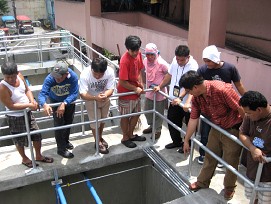
Throughout history, most major cities sprouted alongside rivers to facilitate trade and transport. The Philippine's Pasig River is the main artery through Metro Manila and nature's pathway between Laguna Lake and Manila Bay. Being at the center of commerce has left the Pasig River with floating trash and oil slicks from the many homes, open markets, and businesses along its banks and canals. Collaboration between local government agencies, community organizations, USAID, and Rotary International has resulted in one modest way to fight the effects of urbanization with the Sta. Ana Public Market Wastewater Treatment Plant.
Along the Pasig River's troubled journey through Manila lies the bustling Sta. Ana district's public market with its 220 vendors. Until recently, the market operated by discharging its sewage, grease, and other wastewater into a septic tank, only to have the overflowing tank spill inadequately treated water directly into the already overburdened and "biologically dead" Pasig River. Stakeholders decided to address the pollution from the market as a critical step in the urban waterway's long road to recovery by creating a new wastewater treatment plant.
The market's new plant uses sustainable "green" technology. The plant is part of the USAID-Rotary Pasig River Improvement Project, an effort supported by the USAID-Rotary International H2O Collaboration. Launched on World Water Day in March 2009, the International H2O Collaboration has begun implementing sustainable long-term water, sanitation, and hygiene projects in the Dominican Republic, Ghana, and the Philippines.
More than 60% of the Pasig River's pollution comes from domestic wastewater, mostly from individual households. To address this issue on a larger scale across Metro Manila, two private water utilities are planning to build large sewage collection and treatment systems. The entire city should be covered by 2030.
"In the meantime, Manila's public markets are significant contributors to the river's pollution and easier to address," said Joy Jochico, USAID/Philippines Urban Environment Specialist. "Smaller, decentralized facilities are a good option for public markets because they generate such high-strength wastewater."
The Sta. Ana Wastewater Treatment Plant uses a hybrid system that is easy to operate and maintain and costs less than conventional treatment technologies—factors that make it possible for local governments to sustain this level of treatment. It is a good fit for crowded urban settings because of its relatively small footprint.
The technology has lower operating costs because it significantly reduces organic pollutants, which decreases the energy needed in the aeration stage of treatment. The system harnesses naturally occurring bacteria to break down pollutants; the only chemical used is chlorine for disinfection prior to final discharge to the river.
The project also aims to reduce the pollution entering the Pasig River by integrating effective wastewater treatment with behavior change programs. Activities include improving solid waste management in the market and six neighboring areas to decrease the amount of trash entering the river and implementing sanitation and hygiene programs in nearby schools.
The Philippines' Sta. Ana plant is the culmination of efforts by the Metro Manila Development Authority (MMDA) and the City of Manila. MMDA contributed in-kind labor and equipment; Rotary International District 3810 purchased the construction materials; and the USAID Philippine Sanitation Alliance provided technical assistance.
In January 2010, the partners held focus group discussions and workshops for market vendors, local officials, schools, the neighboring historic church, City of Manila staff, and other establishments around the market in an effort to involve them in project activities.
In addition, the Lola Grande Foundation, a community organization and grantee of the USAID-Rotary project, has intensified education campaigns to promote improved hygiene and reduce open defecation in the surrounding communities. The hope is that a cleaner environment will bring tourists to historic Sta. Ana and improve public health in the district.
After five months of construction, the plant opened in September 2010 and so far is showing great success. "We hope that Sta. Ana will be a model for other public markets in Manila and the rest of the Pasig River area that need to start treating their wastewater," said Connie Beltran, Immediate Past District Governor of Rotary International District 3810. The MMDA plans to replicate the plant in other areas of Metro Manila. It is an encouraging development for a small program with the potential to make big progress—not only in Manila, but in other urban settings around the world.
A. Gambrill







Comment
Make a general inquiry or suggest an improvement.